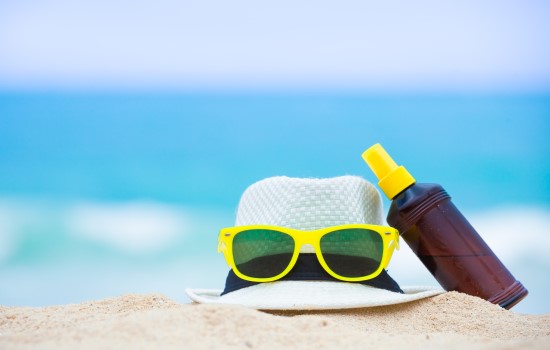Staying Sun Smart
As temperatures rise, protecting ourselves from the harm of UV radiation and staying sun smart becomes increasingly important.
We all know the Slip, Slop, Slap slogan that encourages us to Slip on a shirt, Slop on some sunscreen and Slap on a hat. But did you know that SunSmart now encourages everyone to Seek some shade and Slide on some sunglasses? The additions recognise that we should do all we can to limit our exposure to UV radiation. But what is UV radiation and why do we need to limit our exposure?
What is Ultraviolet radiation?
According to Sun Smart, a program from Cancer Council Victoria and VicHealth, UV radiation is a ‘type of energy produced by the sun’ that causes sunburn, tanning, premature aging and eye damage. It is the main cause of skin cancer.
This energy produced by the sun appears as three wavelengths: UVA, UVB and UVC. UVA and UVB are the two we hear about a lot because they are the two that reach the surface of the earth and pose the biggest risk.
While we can see and feel the light and heat of the sun, UVA and UVB rays are invisible. That means that we won’t see or feel the damage caused by UV radiation until it’s too late.
How to protect yourself from UV radiation?
Following the Slip, Slop, Slap, Seek and Slide slogan will go a long way to helping you to protect yourself from the sun’s damaging rays.
Slip on a shirt
Good sun protective clothing includes tops with collars and sleeves and pants or skirts of at least three-quarter length. Sun Smart suggests that ‘tightly woven, lightweight natural fabrics such as linen, cotton or hemp’ provide better sun protection. In addition, layering of garments and darker colours also keep you better protected from harmful UV radiation.
Slop on some sunscreen
When deciding what sunscreen to buy, opt for a SPF30 or SPF50, both of which provide good sun protection if they’re applied correctly. Look for a broad-spectrum sunscreen that will help protect you from both UVA and UVB. And always check the use by date and store the sunscreen in temperatures below 30 degrees.
When applying sunscreen, don’t skimp! SunSmart suggests a ‘teaspoon of sunscreen for [your] head and neck, each limb and for the front and the back of the body’. And remember to apply at least twenty minutes before you head outside and to reapply every two hours or after swimming or excessive sweating. If you’re not sure what kind of sunscreen you should be using, talk
with your doctor or chemist.
Slap on a hat
When talking sun protection, not all hats are equal. Look for a hat with a wide brim, at least 7.5cm, a bucket hat or a legionnaire hat. Sun Smart does not recommend baseball caps as an everyday option however they are a good choice for active recreation where other styles like wide brimmed hats may not be practical.
Seek shade
Finding some shade when you’re outside is a good way to protect yourself from UV radiation. Look for trees, shrubs or the shadows cast by buildings or pergolas or shade sails. And don’t forget portable shade like umbrellas.
Slide on some sunglasses
Like hats, not all sunglasses are equal when it comes to sun protection. Sun Smart suggests a few things to look out for when choosing sunglasses. First, choose a ‘close-fitting, wrap-around style’. Second, check that the sunglasses meet the Australian Standard (AS/NZS1067:2003). The Australian Standard includes five categories of sun protection. Sun Smart recommends choosing category 2 or higher. If the sunglasses boast an Eye Protection Factor or EPF, look for a rating of 9 or 10.

But what about Vitamin D?
Vitamin D is an important hormone that helps the body to control calcium levels in our blood. We need Vitamin D to ensure strong bones and muscles. While we can get small amounts of Vitamin D from foods like fish and
eggs, the sun is the best source of Vitamin D. So how do we ensure we get
enough Vitamin D while staying sun safe?
During spring and summer, when UV levels are high and we’re often spending more time outdoors, you only need a few minutes of UV exposure mid-morning or mid-afternoon. People who may be at risk of Vitamin D deficiency include people with naturally very dark skin, people who avoid the sun or who spend a lot of time inside, those who wear covering or concealing clothing and people with disabilities or diseases that impact Vitamin D metabolism including cystic fibrosis, coeliac disease and inflammatory bowel disease.
There is only so much Vitamin D the body can absorb, so spending more time in the sun won’t increase your Vitamin D levels, but it may increase the risk of sun damage that can lead to skin cancer. So, remember, while Vitamin D is important, it’s equally important to Slip, Slop, Slap, Seek and Slide.
Please note the information supplied is general in nature. Please consult your medical practitioner for individual advice.
Staying sun smart originally appeared in Issue 29 of Inform Magazine
Ready to read more? Try these Inform links:
The invisibility of an invisible illness
Ready to quit smoking? Here’s some tips and tricks to help you

